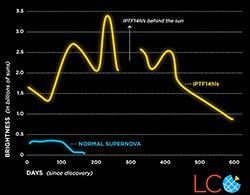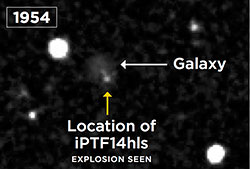"Zombie"-Supernova is puzzling scientists
Star explodes once again about 50 years after its last supernova
Cosmic revenant: An ordinary supernova astounds astronomers, because the glow of the star explosion lasted six times as long as usual and wavered, instead of fading. Even stranger, however: the same star exploded in 1954 in a supernova. Why it survived and has now exploded again, can not be explained with the current models, as the researchers report in the journal "Nature".

Normally, with a supernova the star core collapses and only one neutron star or black hole remains -
but not with iPTF14hls. © ESO/M. KornmesserA so-called type IIP supernova ordinarily follows clear rules: The core of a star rich in mass collapses and causes a violent explosion. With this the star cover rich in hydrogen is blown off and in the center only a neutron star remains – an extremely thick object consisting of exotic matter. The shock wave of the explosion lights up the thrown out gases and generates mostly about 100 days of constant lighting up of this supernova.
"Impossibly" long glow
Now, however, astronomers around Iair Arcavi at the Las Cumbres Observatory in California have discovered a supernova that does not fit this scheme or any other type of supernova. When they registered the flare of a star 800 million light-years away in September 2014, everything seemed quite normal: the spectrum of iPTF14hls' light was exactly the same as that of an IIP supernova, and the temperature of around 5,000 to 6,000 Kelvin was just right.
But when the astronomers re-targeted the same position in January 2015, they discovered the surprising : The supernova was still shining and did not seem to want to stop at all.
Instead of a 100-day plateau the light curve from iPTF14hls lasted more than 600 days, report Arcavi and his colleagues. It seems almost, as if in this explosion everything happens 10 times slower than normally.
The first explosion already in 1954

The light curve of the supernova iPTF14hls is totally different to all other star explosions. © LCO/ S. Wilkinson
Also strange: The brightness of the explosion did not simply decrease after the initial summit, as is usual with such a supernova. Instead, iPTF14hls has brightened and darkened at least five times over the last three years, as the astronomers report. In addition, according to the spectral lines, the ejected or exploded elements move differently than usual.
However, it becomes even more puzzling: When the researchers looked in archive data for hints to the prehistory of the star, they bumped into astonishing: In 1954 a supernova had already occurred at the exactly same location.
All these data speak for the fact that there must have been a high-energy pre-supernova outbreak, the astronomers report.
Survived the star death

This image made by the Palomar Observatory Sky Survey in the year of 1954 shows a supernova at exactly the same position. © POSS/DSS/LCO/ S. Wilkinson
This supernova contradicts all what we believed to know about these events, says Arcavi. It is the biggest riddle which I have met in nearly one decade of research in stellar explosions.
Astronomers suspect that the parent star must have been at least 50 times more massive than the sun, perhaps even up to 130 solar masses. Because only such giants under the stars could have survived the first supernova.
A "dinosaur of the universe"?
Perhaps, according to the researchers, iPTF14hls is the first known representative of a supernova type that has so far only been postulated theoretically. In these "pulsational pair instability" supernovae, the core of massive stars becomes so hot that energy inside is transformed into antimatter and matter. This triggers an explosion that blows away the outer hull of the star but leaves the core intact. Only after multiple repetitions the core then collapses and a black hole is created.
However, these explosions were typical for the early universe – today they might seem not to be really valid any more, says Arcavis Mr. Andy Howell. It's like finding a live dinosaur today.
Furthermore, some of the signs of this supernova do not fit to the theory of this supernova type, under it the persistent presence of hydrogen or the enormously high energy of the explosion.
Only one thing seems to be clear: The supernova iPTF14hls fits in none of the current models and could show an absolutely new type of star explosion. Which mechanisms are behind this puzzling event, remains a secret which the astronomers will have to solve.
Source: Nature, in 2017; doi: 10. 1038

nice post @n3bul4
Thanks!
That was really interesting - I had no idea it was even possible to survive a supernova!
Yes, very interesting... Basically it is very unlikely to survive a supernova. Normally, near planets are literally vaporized after some time. Others may survive if they are far away and / or have enough mass, but anyhow life as we know it is eradicated. However, as far as I know nothing the like has been observed so far.
You inspired me to post my first astronomy-related Steem post today - thanks for the inspiration :)
Wow, I feel honored. Nice post by the way....I just upvoted it. Keep it on!
nice
The stuff that happens in this universe is just..... out of this world ;) But seriously, it's insane how we humans think we know so much, yet we really know ABSOLUTELY NOTHING!!! Great post, thanks for the info!
This wonderful post has received a bellyrub 10.25 % upvote from @bellyrub. Please make sure to vote for my pops as a witness @zeartul,Here
Congratulations! This post has been upvoted from the communal account, @minnowsupport, by n3bul4 from the Minnow Support Project. It's a witness project run by aggroed, ausbitbank, teamsteem, theprophet0, someguy123, neoxian, followbtcnews/crimsonclad, and netuoso. The goal is to help Steemit grow by supporting Minnows and creating a social network. Please find us in the Peace, Abundance, and Liberty Network (PALnet) Discord Channel. It's a completely public and open space to all members of the Steemit community who voluntarily choose to be there.
This post has received a 4.11 % upvote from @booster thanks to: @n3bul4.
This post has received a 5.56 % upvote from @sleeplesswhale thanks to: @steem-buzz.
Great read. Our Civil Air Patrol got a report on this Zombie star a few nights ago and we were all intrigued as to the details of this strange stellar event. Nice to hear more details... I'll be sure to share with our aerospace hungry squadron.